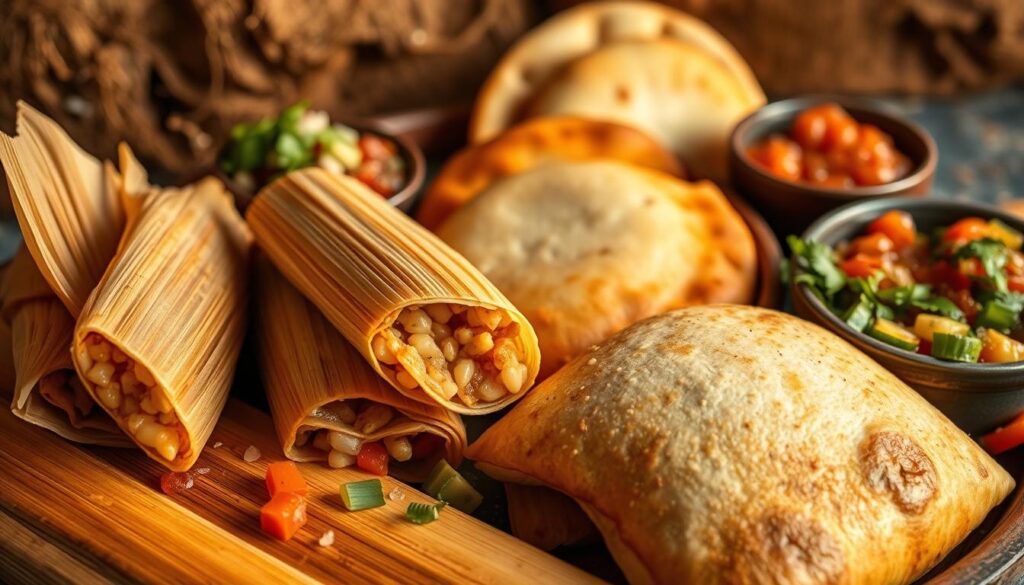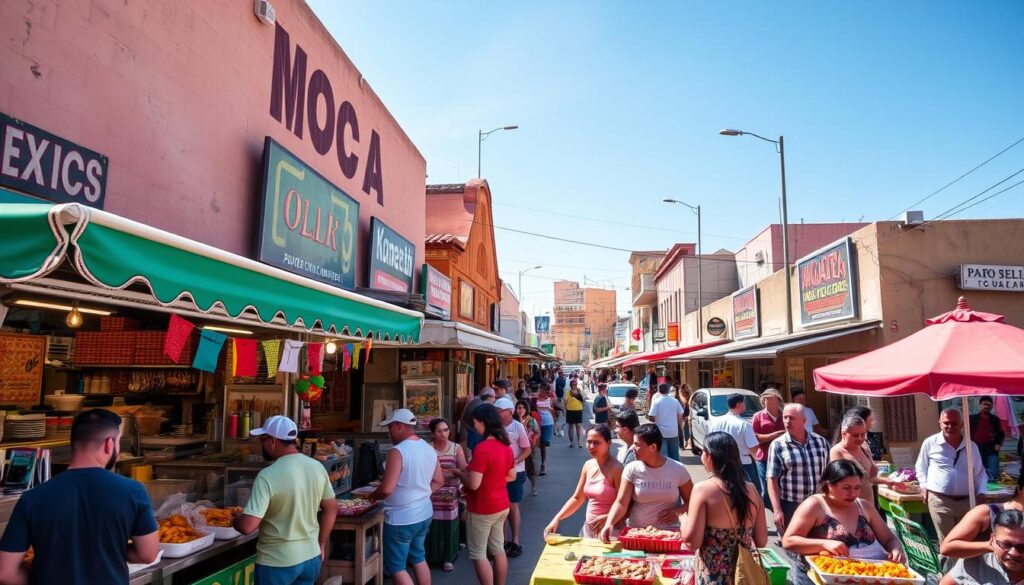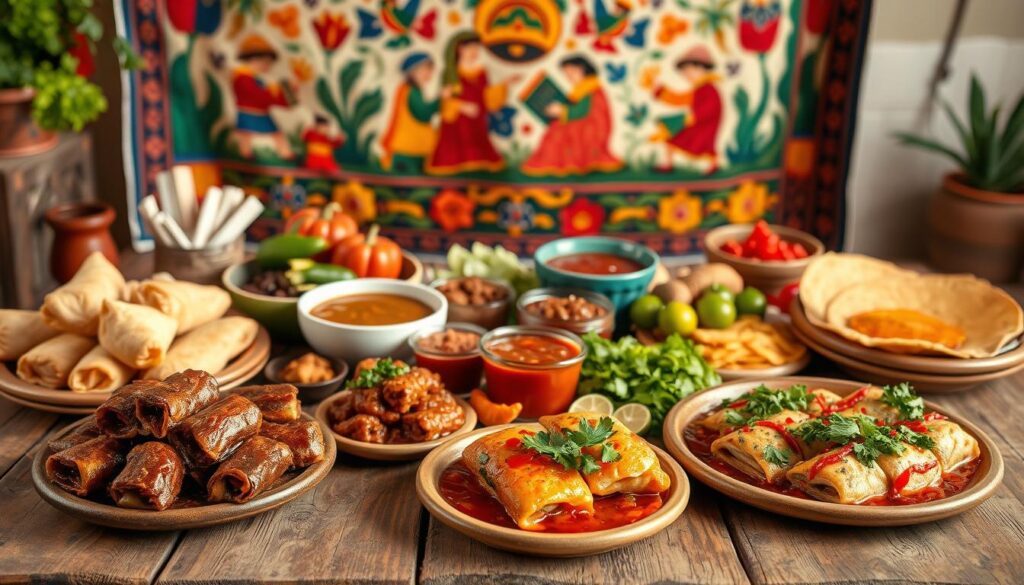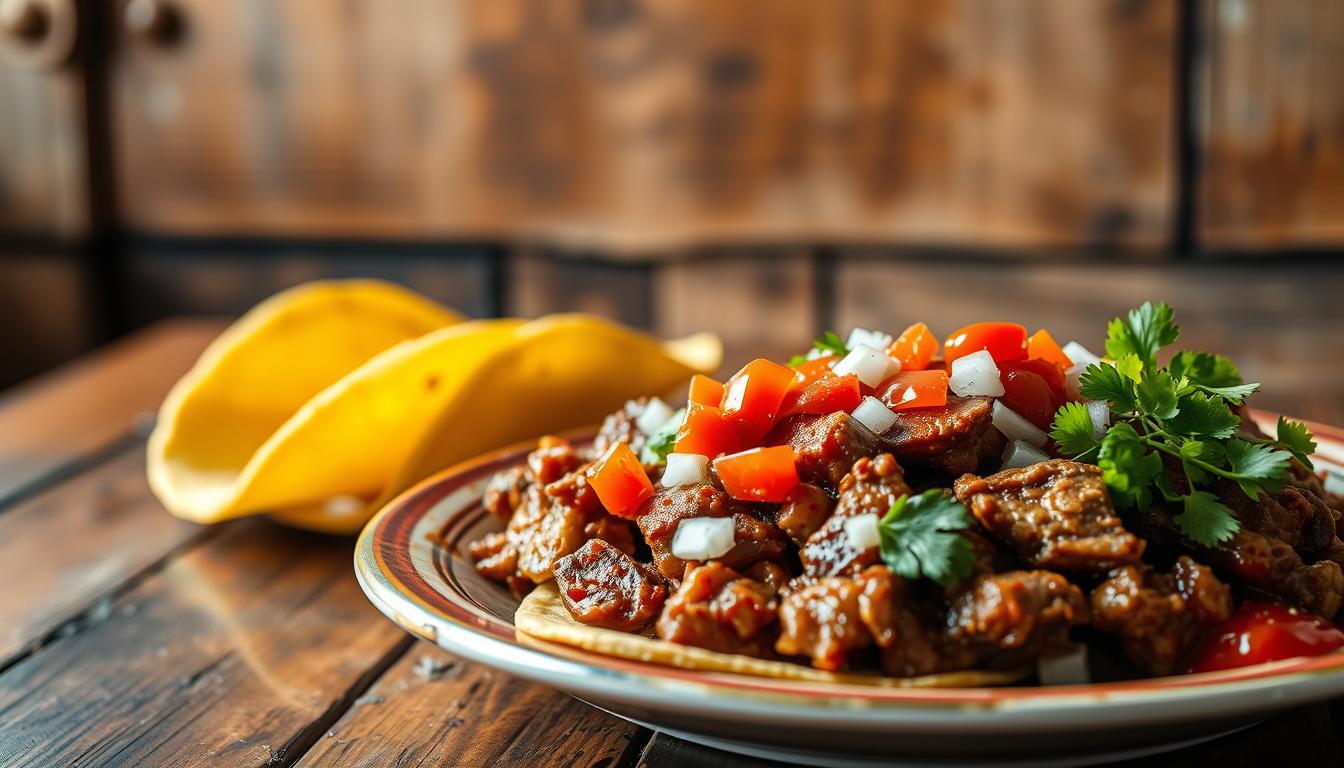Discover the rich flavors of traditional Mexican food, a culinary journey that goes beyond the familiar Americanized versions. Mexican cuisine is a vibrant blend of indigenous Mesoamerican cooking techniques and European elements introduced after the Spanish conquest.
This diverse cuisine varies significantly by region, with each area boasting its own specialties and cooking methods. In 2010, UNESCO recognized traditional Mexican cuisine as an Intangible Cultural Heritage of Humanity, acknowledging its cultural significance.
The beauty of this cuisine lies in its use of fresh ingredients and time-honored techniques, creating a balance of flavors that is more than just spicy. This guide will help you navigate the world of Mexican cuisine, from street tacos to complex moles, and appreciate its depth.
Key Takeaways
- Explore the diverse regional specialties of Mexican cuisine.
- Understand the blend of indigenous and European influences.
- Learn about the importance of fresh ingredients and traditional cooking techniques.
- Discover various categories of Mexican dishes.
- Appreciate the cultural significance of Mexican cuisine as recognized by UNESCO.
The Rich Heritage of Mexican Culinary Traditions
Mexican cuisine is a rich tapestry woven from centuries of cultural influences and culinary traditions. It has evolved significantly over time, incorporating various elements while maintaining its distinctive flavor profiles.
Beyond Tex-Mex: Understanding True Mexican Food
Many people outside of Mexico are familiar with Tex-Mex, a fusion cuisine that developed in the southwestern United States. However, traditional Mexican cuisine is far more diverse and complex. It has its roots in indigenous ingredients and cooking techniques, later influenced by Spanish colonization.
Regional Diversity in Mexican Cooking
Mexico’s culinary landscape is characterized by significant regional variations. The coastal regions are known for their dishes featuring fresh seafood, such as the Veracruz style, which combines Spanish, African, and indigenous influences. In contrast, the Yucatán region is famous for its achiote-infused specialties, while Oaxaca is renowned for its complex moles.
The diversity in Mexican cuisine is largely due to the country’s varied geography and climate, which have shaped different regional cooking styles. For instance, the “holy trinity” of Mexican cooking—corn, beans, and chiles—has been fundamental since pre-Columbian times, providing a foundation for a wide range of foods and taste experiences.
| Region | Specialties | Influences |
|---|---|---|
| Veracruz | Seafood dishes | Spanish, African, Indigenous |
| Yucatán | Achiote-infused dishes | Mayan, Spanish |
| Oaxaca | Complex moles | Indigenous, Spanish |
As noted by chef and food writer, Diana Kennedy, “Mexican cuisine is not just about the food; it’s about the culture, the history, and the people.” This quote highlights the depth and richness of Mexican culinary traditions.
Essential Ingredients in Authentic Mexican Cuisine

Understanding the essential ingredients in Mexican cuisine is key to appreciating its rich culinary heritage. The country’s cooking is deeply rooted in its authentic ingredients, which play a crucial role in defining its flavor profiles.
The Foundation: Corn, Beans, and Chiles
Corn is at the heart of Mexican cuisine, used in making tortillas, tamales, and various other dishes. The variety of beans used in Mexican cooking provides a vital source of protein and adds depth to the flavor. Chiles, both fresh and dried, contribute a complexity that goes beyond mere heat, adding a rich dimension to Mexican dishes.
Fresh Herbs and Spices That Define Mexican Flavors
Fresh herbs like epazote, Mexican oregano, and cilantro are essential in giving authentic Mexican dishes their distinctive taste. These herbs, along with various spices, are used to create the complex flavor profiles characteristic of Mexican cuisine.
Traditional Cooking Tools and Techniques
Traditional Mexican cooking often employs tools like the molcajete (stone mortar and pestle), comal (flat griddle), and metate (grinding stone). Techniques such as nixtamalization are fundamental to authentic Mexican cooking, enhancing the flavor and nutritional value of corn.
Iconic Street Tacos: Mexico’s Beloved Fast Food

Mexico’s streets come alive with the sizzle and aroma of authentic street tacos, a beloved fast food that has gained worldwide recognition. Unlike their American counterparts, Mexican street tacos are characterized by their simplicity, small size, and the use of soft corn tortillas.
Tacos al Pastor
Tacos al pastor are often hailed as the king of Mexican street food, with a history influenced by Lebanese immigrants who introduced the concept of vertical spit cooking. The marinated meat, typically pork, is cooked on a vertical spit and served with pineapple, onions, and cilantro.
Regional Taco Varieties Worth Trying
Mexico boasts a diverse array of taco varieties, each with its unique flavors and ingredients. Some notable mentions include Baja fish tacos, tacos de canasta, tacos de cabeza, and tacos de carnitas. Exploring these regional specialties is a culinary adventure worth taking.
The Art of Taco Toppings and Salsas
The beauty of Mexican tacos lies not only in the meat but also in the accompanying salsa and toppings. Fresh, vibrant salsas made from ingredients like tomatoes, chilies, and cilantro add a burst of flavor to each bite. Understanding the art of taco toppings is essential to appreciating authentic Mexican cuisine.
In conclusion, street tacos are a testament to Mexico’s rich culinary heritage, offering a delicious and convenient meal that showcases the country’s love for bold flavors and simple, high-quality ingredients.
Mouthwatering Masa Creations
Masa, or nixtamalized corn dough, is the backbone of various beloved Mexican dishes. It’s a fundamental ingredient that has been used for centuries in Mexican cuisine.

Tamales: Ancient Comfort Food Wrapped in Tradition
Tamales are a traditional Mexican dish with pre-Columbian origins, filled with meat, cheese, or vegetables, and steamed in corn husks or banana leaves. The process of making tamales is labor-intensive and involves preparing the masa, filling, and then steaming them.
Sopes, Huaraches, and Memelas: Thick Masa Delights
Thicker masa creations like sopes, huaraches, and memelas serve as the base for various toppings such as beans, meats, cheese, and salsa. These dishes showcase the versatility of corn in Mexican cuisine.
Enchiladas: The Versatile Mexican Classic
Enchiladas are a classic Mexican dish that differs significantly from their Americanized versions. They can be filled with various ingredients and covered in a range of sauces, from Enchiladas Suizas to Enchiladas Potosinas, highlighting regional variations.
Masa-based dishes have sustained Mexican people for millennia, demonstrating the importance of corn tortillas and masa in their culinary heritage.
Authentic Mexican Soups and Stews
Soups and stews play a significant role in Mexican cuisine, bringing families together with their rich flavors. These comforting dishes are often considered complete meals, incorporating a variety of ingredients and meat, making them a staple in Mexican households.
Pozole: A Celebratory Hominy Stew
Pozole is a traditional Mexican stew with pre-Hispanic origins, made with hominy and a variety of proteins. It comes in red, white, and green varieties, each with its unique flavor profile. This dish is typically served during celebrations and is customizable with an array of garnishes.
Menudo and Birria: Traditional Weekend Specialties
Menudo, a spicy tripe soup, is a weekend tradition, often served as a hangover cure. Birria, originating from Jalisco, is a flavorful stew made with goat or beef, slow-cooked in a rich broth. Both are beloved for their depth of flavor and cultural significance.
Sopa de Lima and Other Regional Favorites
Regional specialties abound in Mexican cuisine, with soup being a common thread. Sopa de Lima from the Yucatán, Caldo Tlalpeño from central Mexico, and Caldo de Siete Mares from coastal regions showcase the diversity. These dishes often require long time to prepare but result in deeply satisfying meals that incorporate corn in various forms.
The Art of Mexican Salsas and Condiments
Salsas are more than just condiments in Mexican cuisine; they’re integral components that elevate every dish. Mexican salsas and condiments are diverse, ranging from fresh, raw ingredients to complex, cooked sauces.
Fresh vs. Cooked Salsas: Understanding the Differences
Fresh salsas, like pico de gallo, are made with raw ingredients and are typically used as dips or toppings. Cooked salsas, on the other hand, are simmered to develop a deeper flavor and are often used as sauces for dishes like enchiladas.
Guacamole: The Perfect Avocado Dip
Guacamole is a classic Mexican dip made from ripe avocados, onions, chiles, and lime juice. Its simplicity and rich taste make it a favorite.
Mole: Complex Sauce with Ancient Roots
Mole poblano is a rich, complex sauce made with chiles, chocolate, nuts, and spices. It represents the complexity of Mexican cuisine, with often 20+ ingredients and significant preparation time.
Slow-Cooked Mexican Meat Dishes
In Mexican cooking, slow-cooking is a time-honored technique that transforms tougher cuts of meat into culinary masterpieces. This traditional method allows for the development of complex flavors and tender textures that are characteristic of many beloved Mexican dishes.
Cochinita Pibil: Yucatán’s Citrus-Marinated Pork
Cochinita pibil is a signature dish from the Yucatán region, made by marinating pork in a mixture of citrus juice, spices, and achiote paste, then slow-cooking it in banana leaves. This process infuses the pork with a rich, tangy flavor and tender texture.
Barbacoa: Tender Meat with Smoky Flavors
Barbacoa is a traditional method of slow-cooking meat, often lamb or goat, in an underground pit. The result is tender, smoky meat that’s full of flavor. This technique has been adopted in various forms across Mexico.
Carnitas: Crispy Yet Tender Pork Confit
Carnitas, or “little meats,” are made by simmering pork in lard until it’s tender, then crisping it to create a satisfying contrast of textures. This dish showcases the Mexican talent for transforming simple ingredients into complex, flavorful meals through time and technique.
| Dish | Main Ingredient | Cooking Method |
|---|---|---|
| Cochinita Pibil | Pork | Slow-cooked in banana leaves |
| Barbacoa | Lamb or Goat | Slow-cooked in an underground pit |
| Carnitas | Pork | Simmered in lard |

Coastal Mexican Seafood Specialties
With coastlines along the Pacific and the Gulf of Mexico, the variety of seafood in Mexican cuisine is vast and exciting. Mexico’s extensive coastlines have given rise to a rich tradition of seafood dishes, often overlooked in international Mexican restaurants.
Ceviche: Citrus-Marinated Fresh Fish
Ceviche is a staple in Mexican seafood cuisine, where fresh fish is “cooked” in lime juice, mixed with onions and cilantro. Regional variations abound, from the Baja Peninsula to the Yucatán.
Pescado a la Veracruzana: A Colonial Fusion Dish
Pescado a la Veracruzana showcases the fusion of indigenous, Spanish, and Mediterranean influences. This dish features fish cooked in a rich tomato and olive sauce, finished with capers.
Camarones and Other Shellfish Preparations
Mexican cuisine offers a variety of shrimp dishes, such as Camarones al Mojo de Ajo (garlic shrimp) and Camarones a la Diabla (spicy shrimp). These dishes highlight the use of fresh ingredients and bold flavors.
Mexican Breakfast Traditions
In Mexico, breakfast is more than just a meal; it’s a cultural cornerstone that brings families together. This meal is often the largest of the day, featuring a variety of dishes that highlight the country’s culinary richness.
Chilaquiles: The Ultimate Comfort Breakfast
Chilaquiles is a beloved breakfast dish made from fried corn tortillas cut into quarters and simmered in a spicy tomato sauce. The dish is often topped with crema, cheese, and eggs or chicken, making it a hearty start to the day.
Huevos Rancheros and Other Egg Dishes
Huevos rancheros, a classic Mexican breakfast, consists of fried eggs on top of corn tortillas, smothered in a freshly made sauce. Other popular egg dishes include huevos divorciados, huevos motuleños, and huevos a la mexicana, each offering a unique flavor profile.
Sweet Morning Treats: Pan Dulce and Churros
Mexican breakfasts often include sweet treats like pan dulce (sweet bread) and churros, typically enjoyed with a rich, spicy hot chocolate. This combination is a delightful way to start the day, blending sweet and savory flavors.
At breakfast time, families gather to enjoy these traditional dishes, making it a special moment to share together.
Authentic Mexican Street Food Beyond Tacos
Mexico’s street food is a vibrant reflection of its culture, with many dishes waiting to be discovered. The variety of street food in Mexico is astonishing, offering a culinary journey through different regions and traditions.

Elote and Esquites: Mexican Street Corn
Elote, or corn on the cob, is a staple of Mexican street food, typically grilled and slathered with mayonnaise, lime juice, cheese, and a sprinkle of chile powder. Esquites, corn kernels served in a cup, offer a similar flavor profile in a more portable format.
Tortas and Cemitas: Mexican Sandwiches
Tortas and cemitas are Mexico’s answer to sandwiches, featuring crusty bread filled with various meats, cheeses, and condiments. Regional variations abound, making each a unique reflection of local tastes.
Tostadas and Flautas: Crispy Delights
Tostadas are crispy corn tortillas topped with a variety of ingredients, from refried beans to grilled seafood. Flautas, or “flutes,” are rolled tortillas filled with meat or cheese, then fried until crispy, often served with sour cream or salsa.
Mexican street food is not just about the food; it’s an integral part of urban culture, providing affordable and quick meals for workers and a sense of community.
Regional Mexican Specialties
Mexico’s culinary landscape is as diverse as its geography, with each region offering a unique flavor profile that reflects its history and culture. This diversity is evident in the various regional specialties that make Mexican cuisine so rich and varied.
Oaxacan Cuisine: Land of Seven Moles
Oaxacan cuisine is renowned for its complexity and depth of flavor, particularly in its seven traditional moles. These sauces, made with ingredients like chiles and chocolate, are a hallmark of Oaxacan cooking. Other specialties include tlayudas, tetelas, and quesillo, a type of string cheese.
Yucatecan Flavors: Achiote and Citrus
Yucatecan cuisine stands out for its use of achiote, sour oranges, and habanero chiles. Signature dishes beyond cochinita pibil include sopa de lima, papadzules, and poc chuc, showcasing the region’s unique flavor profile.
Puebla’s Contributions to Mexican Gastronomy
Puebla is known for its significant contributions to Mexican cuisine, including chiles en nogada and mole poblano. The region is also famous for its cemitas, a type of sandwich that reflects the local taste and tradition.
| Region | Specialties | Key Ingredients |
|---|---|---|
| Oaxaca | Moles, Tlayudas, Quesillo | Chiles, Chocolate |
| Yucatán | Cochinita Pibil, Sopa de Lima | Achiote, Sour Oranges, Habanero Chiles |
| Puebla | Chiles en Nogada, Mole Poblano | Poblanos, Walnuts, Chocolate |
Each region in Mexico offers a unique culinary experience, reflecting local ingredients, historical influences, and cultural traditions. Traveling through Mexico allows one to taste the diverse flavors that make Mexican cuisine so beloved, with each place offering its own distinct dishes.
Mexican Holiday and Celebration Foods
In Mexico, food is more than just sustenance; it’s a way to honor heritage and celebrate special occasions. Traditional Mexican cuisine plays a significant role in various holidays and festivities throughout the year.
Day of the Dead Specialties
During Día de los Muertos, families prepare traditional dishes to honor their loved ones. These include pan de muerto, sugar skulls, and the deceased’s favorite foods. These offerings are believed to guide the spirits back to their families and provide them with nourishment on their journey.
Christmas Season Favorites
Christmas in Mexico is celebrated with delicious foods like bacalao (salt cod), ponche navideño (Christmas punch), and buñuelos. The tradition of posadas, a nine-day celebration leading up to Christmas, is also marked with special dishes and sweets.
Chiles en Nogada: Mexico’s Patriotic Dish
Chiles en nogada is a iconic dish representing the colors of the Mexican flag. It’s traditionally served around Mexican Independence Day. This dish requires significant preparation time and is often made collaboratively by family members, making it a true celebration of traditional Mexican cuisine and family bonding.

Traditional Mexican Beverages
From refreshing aguas frescas to rich hot chocolate and potent spirits, Mexican beverages are as diverse as they are flavorful.

Aguas Frescas: Refreshing Fruit Waters
Aguas frescas are a staple in Mexican cuisine, offering a refreshing alternative to plain water. Popular flavors include jamaica (hibiscus), horchata (rice drink), and tamarindo, made by blending fruits, flowers, or seeds with water and a touch of sugar.
Mexican Hot Chocolate and Atole
Mexican hot chocolate has pre-Columbian roots, made with rich, dark chocolate and frothy milk, whisked with a molinillo for a creamy texture. Atole, a warm corn-based drink, is often flavored with vanilla or chocolate, known as champurrado.
Tequila, Mezcal, and Other Spirits
Mexico is renowned for its spirits, particularly tequila and mezcal, made from the agave plant. Other lesser-known beverages include pulque, raicilla, and bacanora, each with unique production methods and flavors.
Mexican Desserts and Sweet Treats

The world of Mexican sweets is a vibrant and diverse reflection of the country’s culinary heritage, blending indigenous and European influences. Mexican desserts are not just sweet treats; they are a culmination of cultural traditions and historical influences that have shaped the country’s cuisine over centuries.
Flan and Custard-Based Desserts
Flan, a creamy custard dessert, is a staple in Mexican cuisine, with its origins tracing back to Spanish cuisine. The preparation involves caramelizing sugar, mixing it with eggs, and baking until set. Other custard-based desserts include arroz con leche (rice pudding) and capirotada (bread pudding), which are comforting and rich in flavor.
Fruit-Based Sweets and Candies
Mexican cuisine boasts a variety of fruit-based sweets, such as ate (fruit paste), often enjoyed with cheese for a sweet-savory combination. The pairing of fruit with cheese enhances the taste and adds a layer of complexity to the flavor. Other candies like dulce de tamarindo, cocadas (coconut candy), and dulce de leche are popular treats.
Churros, Buñuelos, and Fried Pastries
Churros and buñuelos are fried pastries that are crispy on the outside and soft on the inside, typically enjoyed during special occasions. Churros are coated in cinnamon sugar and often served with chocolate or cajeta for dipping. Buñuelos are deep-fried dough balls, sometimes coated in sugar or honey, and are a favorite during festive times. These desserts showcase the influence of European frying techniques on Mexican sweets.
Mexican desserts often strike a balance between sweetness and other flavors like cinnamon, chocolate, or cheese, creating a complex flavor profile. This balance is a hallmark of Mexican sweets, making them unique and delightful. The use of local ingredients and traditional cooking methods adds to the richness and diversity of these desserts, making them a significant part of Mexican culinary culture.
How to Experience Authentic Mexican Cuisine at Home
With a few essential pantry staples and some basic cooking skills, you can recreate authentic Mexican cuisine at home. The key is to focus on using the right ingredients and techniques that bring out the true taste of Mexico.
Essential Pantry Staples for Mexican Cooking
To start, stock your pantry with essentials like dried chiles, masa harina, Mexican oregano, and proper cheeses. These ingredients form the foundation of many traditional Mexican dishes.
Simple Authentic Recipes for Beginners
Beginners can master simple recipes like basic salsas, guacamole, and quick street tacos. These dishes are not only delicious but also help you get a feel for the flavors and techniques used in Mexican cuisine.
Tips from Mexican Chefs for Authentic Flavors
Mexican chefs emphasize the importance of toasting spices, properly charring chiles, and balancing flavors to achieve authentic taste. By following these tips, you can save time and create dishes that are true to their Mexican roots, making your home a special place for culinary exploration.
Conclusion: Embracing the Authentic Flavors of Mexico
Embracing the authentic flavors of Mexico means more than just trying new food; it’s about experiencing a culture that is deeply intertwined with its culinary traditions. Throughout this article, we’ve explored the diverse and complex world of Mexican cuisine, from the essential ingredients and iconic street tacos to regional specialties and traditional beverages.
We’ve seen that authentic Mexican food goes far beyond the familiar Tex-Mex dishes. It’s a cuisine that is both evolving and rooted in tradition. To truly taste the essence of Mexico, we encourage you to seek out authentic Mexican cuisine in your local area, particularly in family-run restaurants, and to visit different regions of Mexico to experience the true diversity of its cuisine on the street or in a local place. By doing so, you’ll not only broaden your culinary horizons but also deepen your appreciation for Mexican culture and history.


